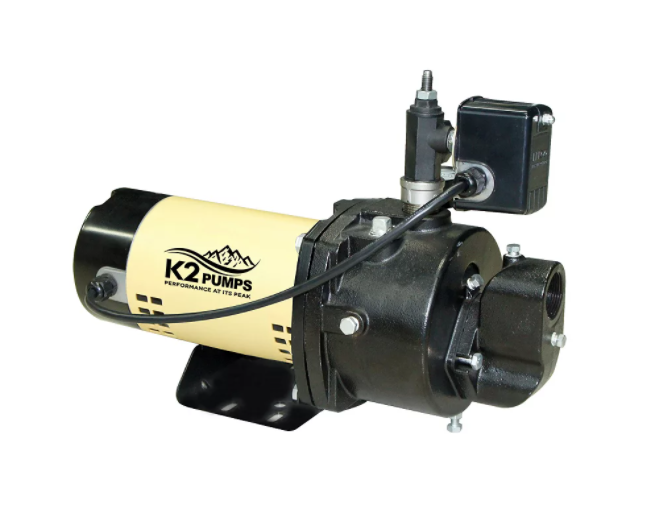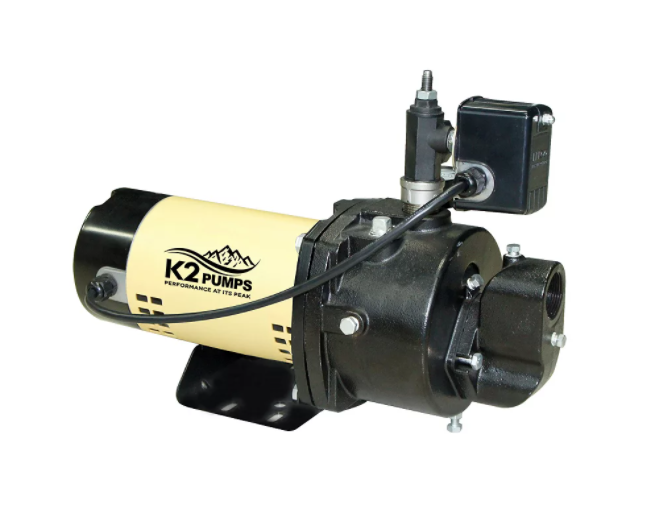K2pumps Jet Pump

SAFETY INSTRUCTIONS
All electrical work should be performed by a licensed electrician.WARNING: Risk of electrical shock. Disconnect power before working on pump, motor, pressure switch or wiring.CAUTION: Motors run hot. Do not touch an operating motor. Before handling the pump, disconnect power and allow the motor to cool down for 20 minutes.Read and follow all safety instructions on the pump label and in the owner’s manual for your pump.
Problem 1: The Pump won’t start or run |
|
| Possible Causes | Corrective Action |
| 1. The power is off. | 1. Turn power on by switching the circuit breaker to the “ON” position. |
| 2. The pump is incorrectly wired or the electrical outlet is bad. | 2. Check the wire connections against the wiring diagram in the owner’s manual. Test the electrical outlet with a voltmeter. |
| 3. The circuit breaker has tripped. | 3. Reset the circuit breaker by switching the breaker to the “ON” position. |
| 4. The voltage being fed to the motor does not match the motor’s rated voltage. | 4. Check the line voltage. Read the label on the pump motor for instructions on selecting the correct voltage. |
| 5. Voltage is too low. | 5. Check with the power company or contact an electrician. If wire size is too small, install heavier wiring. |
| 6. The wires are loose, disconnected or wired incorrectly. | 6. Check the wiring in your owner’s manual. DISCONNECT THE POWER. Following the wiring instructions to check and tighten the wires. When in doubt, contact a licensed electrician. |
| 7. The motor has failed. | 7. Replace the motor or the entire pump. |
| 8. The Pressure Switch is defective. | 8. DISCONNECT POWER. Replace the Pressure Switch. |
Problem 2: The Motor runs but no water is deliveredDisconnect Power. Unscrew priming plug to make sure there is water in the priming hole. |
|
| Possible Causes | Corrective Action |
| 1. The jet pump has not been primed, fully primed or has lost prime. | 1. Follow the pump priming directions in the owner’s manual. You may need to repeat the priming procedure several times. Install a check valve and/or foot valve to help keep the pump primed. Deep Well installation – Pressure regulator must be set properly. Refer to the owner’s manual for instructions on how to connect and set the pressure regulator. |
| 2. The suction line may have air leaks around the joints or connection points. | 2. Check all connections and fittings on the entire length of the suction line. All connections and fittings must be air-tight. |
| 3. The water level is below the suction pipe inlet. | 3. Lower the suction pipe until it is submerged in the water. Reprime the pump. Install a foot valve at the end of the suction pipe. |
| 4. The depth to water level in the well is too low. | 4. The depth to water is the distance from the pump to the water source. Check the manual for the water level specifications of your pump. Shallow well jet pumps only work up to 25′ depth to water. A deep well jet pump is needed if the depth to water is more than 25′ deep. |
| 5. The ejector or impeller is clogged. | 5. Clean the ejector or impeller. |
| 6. The foot valve or inlet strainer is clogged. | 6. Clean the foot valve or inlet strainer, or replace as needed. |
| 7. The check valve or foot valve is stuck in the closed position. | 7. Replace the check valve or foot valve. |
| 8. The pump motor is running on incorrect voltage. | 8. Make sure that the power source matches the pump motor requirements. For dual-voltage motors, the motor should be set at the same voltage to which it is connected. Read the label on the pump motor for instructions on selecting the correct voltage. |
| 9. The piping size is too small, too long, or has too many elbows, causing too much restriction in the suction pipe. | 9. Always use a pipe that is the same size as or larger than the suction port. Keep the length of the suction pipe as short as possible and the number of elbows to a minimum. If you have a long suction pipe, use larger piping. |
| 10. The suction pipe is frozen. | 10. Thaw the pipes out. Make sure the suction pipe is buried below the frost line. Heat the pump house. |
| 12. The suction pipe is buried in mud, sand, dirt or debris. | 12. Lift the suction pipe so that it does not touch the bottom of the well or water source. Install a foot valve to help screen out mud, sand, dirt or debris.
Deep Well installation – Pull jet assembly out and clean |
| 13. Gaseous Well | 13. Consult a licensed well contractor for solutions (e.g. installing a well sleeve or a vented well cap.) |
| 14. Inadequate pump size | 14. Replace with a higher HP pump sized to your application |
| 15. Voltage is too low. | 15. Check with power company or contact an electrician. If wire size is too small, install heavier wiring. |
| 16. Air lock in suction lines. | 16. The horizontal pipe between the well and pump should pitch upwards toward the pump. |
Problem 3: The Pump runs & delivers water for a short time, then shuts off |
|
| Possible Causes | Corrective Action |
| 1. The circuit breaker has tripped. | 1. Reset the circuit breaker by switching the breaker to the “ON” position. |
| 2. The pressure switch is faulty. | 2. DISCONNECT POWER. Check the pressure in the piping. If the pressure is lower than 50 PSI, replace the pressure switch. |
| 3. Voltage is too low. | 3. Check with power company or contact an electrician. If wire size is too small, install heavier wiring. |
| 4. Motor is not properly vented or protected from the outside weather. | 4. Make sure the pump is protected from the outside weather, well ventilated, and there is enough room for air circulation around the pump. |
| 5. Motor is wired incorrectly. | 5. Refer to the wiring instructions in the owner’s manual. |
Problem 4: The Pump moves water, but does not shut off |
|
| Possible Causes | Corrective Action |
| 1. The pressure switch is out of adjustment, not wired correctly or the contacts are stuck in the closed position. | 1. DISCONNECT POWER. Make adjustments to the pressure switch or replace. Inspect the wiring for loose connections or insufficient wire gauge. If the Contacts are stuck in the closed position, replace switch. |
| 2. The pump is not building to the shut-off pressure of the pressure switch. The pressure switch needs to be adjusted. The contact points are welded closed. The switch is defective. | 2. Lower “cut off” setting. Follow instructions under the pressure switch cap.
Adjust pressure switch properly. Replace the pressure switch if the contact points are welded close or the switch is defective. |
| 3. The water level in well is dropping below the suction pipe. Water level is lower than estimated. | 3. Make sure the bottom of the suction pipe is below the water level when the pump is operating. If the water level is dropping below 25′, you will need a deep well jet pump.
Deep Well installation Check the Specifications in the manual to determine the maximum well depth for your model. |
| 4. The pipes leak. | 4. Locate and repair the leak, reconnect the pipes. |
Problem 5: The Pump does not build to shut-off pressure |
|
| Possible Causes | Corrective Action |
| 1. The pump is sucking air. | 1. The suction pipe may have small leaks around the connections where air can be pulled in. The suction pipe and all fittings must be completely airtight. |
| 2. The depth to water level in the well is too low. | 2. The depth to water is the distance from the pump to the water source. Check the manual for the water level specifications of your pump. Shallow well jet pumps only work up to 25′ depth to water. A deep well jet pump is needed if your depth to water is more than 25′ deep. |
| 3. There is debris blocking the pump’s nozzle, venturi, or impeller. | 3. Inspect parts and clean as needed. |
| 4. The voltage being fed to the motor does not match the motor’s rated voltage. | 4. If the jet pump’s motor is set to run on 230 volts but is only being fed 115 volts, it will run at half speed and cannot build proper pressure. Check the line voltage. Read the label on the pump motor for instructions on selecting the correct voltage. |
| 5. The impeller or diffuser shown signs of wear. | 5. Replace impeller, diffuser, along with necessary seals and gaskets. |
| 6. Incorrect nozzle or venturi in use. | Deep Well System
6. Check the manual to determine which nozzle and venturi kit to install for your pump model. Check the ejector package instructions to determine which nozzle and venturi to install in the package for your pump model. |
Problem 6: The Pump starts and stops too frequently |
|
| Possible Causes | Corrective Action |
| 1. The check valve is installed in the wrong place within the system. | 1. The check valve needs to be in piping between the pump and the source of water (well, lake, etc.). It cannot be in piping between the pump and pressure tank. Re-locate the check valve as needed. |
| 2. The check valve or foot valve is leaking. | 2. Replace any faulty check valves or foot valves. |
| 3. The pressure switch is out of adjustment or faulty | 3. DISCONNECT POWER. Make the proper adjustment to the pressure switch. Replace the switch if found to be faulty. |
| 4. Pump cavitation – vibrates and sounds like pumping gravel. | 4. Increase the diameter of the suction piping. Decrease the length of the piping and minimize the number of elbows, tees, valves and fittings. |
| 5. The pipes are leaking. | 5. Repair the pipe connections or replace the pipes. |
| 6. Faucets have been left open | 6. Close faucets |
| 7. Venturi, nozzle or impeller is clogged. | 7. Clean venturi, nozzle or impeller. |
| 8. There are too many elbows or other restrictions between the pressure switch and tank. | 8. Too many restrictions will create a pressure differential that will “fool” the switch. Use fewer elbows, 45’s instead of 90’s, flexible pressure hose instead of pipe and elbows, or anything else you feel will reduce the number of restrictions in the pump system. |
| 9. The tank is too small and not properly sized for the application. | 9. The minimum tank size should be enough to allow the pump to run for a minimum of 60 seconds every time it turns on. If the tank is too small, replace with a larger sized tank. |
| Pre-charged tank (with bladder) | |
| 10. The air charge is too low in the tank. | 10. DISCONNECT POWER and open faucets until all the pressure is relieved. Using tire pressure gauge, check air pressure in the tank at the valve stem located on the tank. If the pressure switch cut-in setting is less than 30 psi, pump air into the tank from an outside source until air pressure is 2 psi less than the cut-in setting of the switch. Check the air valve for leaks (use soapy solution) and replace if necessary. |
| 11. The tank has a damaged bladder or no air cushion | 11. Test the tank by depressing the air valve. The air valve will expel water if the bladder is damaged. Replace the tank if the bladder is damaged. |
| 12. The tank was pre-charged incorrectly. | 12. Add or release air as needed. |
| Standard or Conventional Pressure Tank | |
| 13. The pressure tank is water-logged due to a defective Air Volume Control (AVC) valve | 13. DISCONNECT POWER and drain tank to (AVC) port. Check the AVC valve for defects. If defective, replace. |
| 14. Air leaks in the fittings and the top of the tank. | 14. Check the fittings and the top of the tank for air leaks. Repair leaks or replace tank. |
References
[xyz-ips snippet=”download-snippet”]


